What Is Acquired Brain Damage?

Acquired brain damage occurs after brain injury that occurs after birth. It produces a permanent or temporary deficit, of a physical, mental, cognitive, behavioral, sensory, emotional or social nature, and reduces the functional capacity and quality of life of the child.
It occurs after an injury to brain structures that interrupts the normal development of the child’s brain. Acquired brain damage can be caused by a head injury after suffering an accident or fall, due to lack of oxygen in the brain, brain tumors, cerebrovascular accidents, encephalopathies, refractory epilepsy, radiotherapy of the nervous system and other infectious diseases.
When a child has had a brain injury, the consequences can be delayed until such time as the impaired ability has finished developing. Although at first it seems that the child has no sequelae, after a while certain difficulties become apparent that are not related to brain damage and generate confusion and misunderstanding in the family and at school.
It is recommended that the child with acquired brain damage be cared for by a multidisciplinary team for adequate rehabilitation. To provide comprehensive care, it is convenient that the following professionals intervene: the neuropediatrician, the rehabilitation physician, the neuropsychologist, the clinical psychologist, the physiotherapist, the psychomotor, the speech therapist, the occupational therapist and the child psychiatrist.
What are the consequences of childhood acquired brain damage?
It should be borne in mind that the consequences of brain damage depend on the area of the brain injured, the severity of the injury and the age at which it occurs. Some of the main consequences of acquired brain damage are:
Consequences of a physical and sensory nature
They affect the mobility, activity and safety of the child. These can be compensated with accommodations and assistive products.

Cognitive consequences
Children with acquired brain damage are presented with motor, cognitive and behavioral problems together, which forms a different and specific reality that must be treated as such.
Consequences on communication
If the injury occurs in the dominant lateral hemisphere, it is usually the left side. It is common for communication and the ability to understand and express oral language to be affected , causing aphasia and dyslexia. Difficulty in naming everyday objects can also be manifested, causing anomie. Other times the voice is affected, causing dysphonia.
Consequences for judgment and decision making
Executive functions are commonly affected, since they directly influence the ability to make decisions. The child may have difficulties to start any activity, doubts and inappropriate or ineffective responses to certain situations.
Emotional and behavioral consequences
The behavior of children with acquired brain damage can become inappropriate in and out of school. Behavioral alterations can become apparent after months or years after the injury occurs, and have to do with the nature of the injury and its evolution.
The most frequent manifestations are:
- Low tolerance to frustration.
- Disproportionate anger.
- Aggressiveness.
- Sudden mood swings
- Disinhibition.
- Inappropriate comments.
- Isolation.
- Etc.
What to do to reduce the sequelae of childhood acquired brain damage?
Fatigue
In the event that your child suffers from fatigue, it is best to schedule activities gradually and set frequent rest intervals .
Limitations in memory
When the child has memory limitations, it is advisable to make a memory notebook with a daily agenda, reminders, alarms, etc. As well as facilitating and training in the use of support tools, such as blackboards, calculators, tablets , mobile phones, computer, etc.
Use clues and prompts to promote autonomy when carrying out tasks, such as sticky notes, color codes by subjects, diagrams … It is also good to use tests or tests (whenever possible) so that the child can recognize the correct information. Lastly, it is very important that you learn to relate new information to what you learned immediately before.
Limitations of attention
If the child has an attention deficit, it is important to propose only one task at a time to avoid simultaneous proposals. Unnecessary and distracting elements should be removed from your basic workspace so that you are fully willing to listen and do the task at hand.
Also, it is important to dose the information, not to introduce sudden changes in the activity. In addition to expressing, clearly, the recognition of progress when it occurs.
Limitations in communication
If the child’s limitations have to do with communication, it is essential to use short and clear messages. Encourage him to participate in the conversation, allow time for him to respond, and pay attention to him.
Speak slowly, accompany verbal instructions with written ones. As well as facilitating the use of tools that support communication, such as tape recorders, communicators, tablets … Reducing background noise and avoiding using double language or jokes is also very beneficial.

Limitations in decision making
Regarding limitations in decision-making, it is pertinent to establish a plan or routine that stipulates daily tasks to provide security for the child. Also help him to identify problematic situations in the classroom and in the family and to look for alternative solutions.
In addition, the child must be prepared in advance for any change in routine that may arise in the classroom or in the family. It is convenient to provide diagrams that help the little one to organize and, when in doubt, remind him of a pre-established code that invites him to stop and think.
Limitations of conduct
To reduce this type of limitation, it is convenient to set the limits clearly, avoid confronting inappropriate behavior and divert the child’s attention to something else that may interest him.
Alternatives to inappropriate behaviors should also be provided. Make the pertinent modifications in the environment to avoid inappropriate behaviors and reward the appropriate behavior to generate habit. If the child is uninhibited, it is best not to show excessive concern.
These are some guidelines for the interpretation and management of some behaviors and attitudes that derive from the sequelae of childhood acquired brain damage.










